When I was 16, I started my first season as a safety kayaker for whitewater rafting trips. Each trip I crammed myself into my snug-fitting whitewater kayak, spending hours a day in the uncomfortable, even painful, outfitting, with unwavering devotion to the sport. But then I noticed that at the summer flows on the section of river, the veteran guides were not in their own little boats. They took sit-on-tops and inflatable kayaks instead. Eventually, I came around to jumping in an inflatable myself, and this was when my entire view of enjoying the river changed.
The inflatable made even small wave trains fun to rollercoaster through. In between rapids, I could stretch out like I was in a lounge chair and take in views of the mountains without worrying about catching an edge and flipping. In long pools, I would slide out from the seat to cool off with a swim, and even brought a snorkel to go in search of bounty along the riverbed. Best of all, when I noticed a rafting guest with a look of intrigue at my boat, I would ask if they wanted to borrow it—letting them take it for a spin even through mild whitewater. Seeing someone else with no experience jump in and immediately enjoy themselves was when I began to fully understand inflatable kayaks are one of the best ways to get others into paddling.
You don’t have to go through the same life lesson to reach this conclusion. Let me expedite the decision: Yes, you, or the person you are asking for, should get an inflatable kayak. They make the activity easier to access, don’t have to be loaded onto the roof of a car, and can be loaned to a friend with little worry.
Included here are some of my picks for the best inflatable kayaks out today. The selections included are just a few great options, and I consider the boats provided here as a guide to help when comparing against what’s available and how you plan to use it.
Best inflatable kayaks: Our top picks
- Top budget-friendly inflatable: Advanced Elements AdvancedFrame
- Best whitewater inflatable kayak: AIRE Hot Potato
- Best tandem: Nyce Haul
- Best for lakes and bays: Gumotex Seashine
- Favorite packraft: Kokopelli Recon
- Best inflatable fishing kayak: BOTE LONO Aero
Best budget-friendly inflatable kayak
Advanced Elements AdvancedFrame
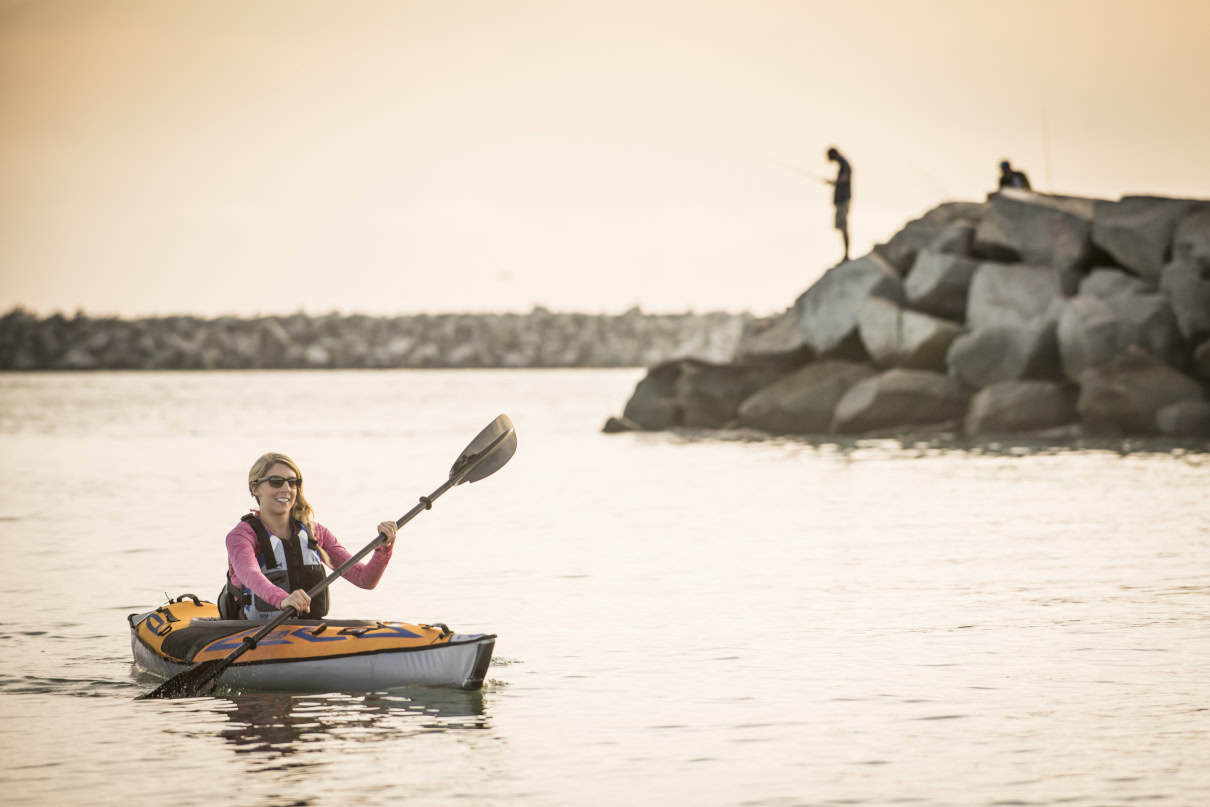
Advanced Elements AdvancedFrame Specs
Length: 10’5”
Width: 32”
Weight: 36lbs
Capacity: 250 lbs
MSRP: $669.99
advancedelements.com
Buy from:
ADVANCED ELEMENTS DICK’S AMAZON
Why I Love It
Advanced Elements has been making great inflatable kayaks since the early 2000s. Their AdvancedFrame line is the equivalent of a recreational or day-touring kayak with a few different models tiered as to what they offer. What I like about Advanced Elements is that you can purchase the budget-friendly AdvancedFrame and still get a well-built boat from a trusted brand.
Finding a budget-friendly inflatable kayak is not as straightforward as the Amazon search results would have you believe. Many of the boats you’ll find for a couple of hundred dollars are, perhaps unsurprisingly, made with thin low durability materials which are also easy to rip on a rock or corner of a dock. They also tend to have cheaper valves and don’t inflate well to an optimum pressure, making them spongy and a pain to paddle.
The AdvancedFrame has a tapered recreational kayak shape that travels well through the water. It has an enclosed, sit-inside style deck. Three layers of material make it puncture-resistant to set your mind at ease around any shoreline twigs or rocks. But, it’s the namesake AdvancedFrame system that makes the boat stand out. Even the standard, low-cost option includes the built-in aluminum rib system to provide more structure to the boat, bringing it closer to a folding kayak experience that is easy to break down and stow away.
Reasons to buy
- Budget-friendly inflatable kayak from a well-established brand
- Tapered shape is like a recreational kayak and great for shorter trips and calmer waters
- AdvancedFrame aluminum rib system helps give more structure to the kayak
Consider another if
- You prefer a sit-on-top style inflatable kayak with an open deck
- You plan to mostly paddle whitewater
- You want the performance and don’t mind storing and transporting a hard-shell kayak
Bottom line
For a similar price to many of the lower-cost hard-shell plastic kayaks, the Advanced Elements AdvancedFrame offers a budget-friendly inflatable kayak that will take you across the lake or your favorite bay.
Best whitewater inflatable kayak
AIRE Hot Potato
AIRE Hot Potato Specs
Length: 7’2″
Width: 36″
Weight: 20 lbs
Capacity: 220 lbs
MSRP: $1,580
aire.com
Buy from:
Why I love it
In recent years, AIRE reinvented the idea of the inflatable kayak with the Spud, a short little boat perfect for kids, smaller adults, and anyone who wants a nimble, playful inflatable for whitewater. The boat offered an alternative to the barges that had been commonplace in the category for decades. The Spud has been an absolute hit, and so AIRE decided to introduce a burlier version of it, fittingly called the Hot Potato.
The Hot Potato is very similar to the Spud, and though AIRE made some small changes to further increase the boat’s abilities, they maintained much of the same characteristics people love about it. The bow and stern are rockered to ride over waves and features. The hull and tube diameters are wide enough to provide plenty of stability, but small enough to pivot around on the river. Inflatables bring stability, which lets people with less experience, or not wanting to be in an enclosed kayak, tackle rapids. And if you do flip, the smaller outer tube diameter and narrower shape of the Hot Potato compared to other inflatable whitewater kayaks is helpful for self-rescuing back into the boat.
The real divergence of the Hot Potato from the Spud comes with the construction. AIRE started with a thicker denier base material and urethane air bladders to increase durability. They also swapped the Summit II air valves for the Leafield C7. Technical hierarchies aside, I find the C7 valve easier on the hands to pop open and close for inflation and deflation. The Hot Potato simply takes what we love about the Spud and brings it up to AIRE’s highest level of build.
Reasons to buy
- Fun, playful whitewater inflatable kayak
- Great size for kids and adults
- burly construction
- Can use with thigh braces
Consider another if
- It doesn’t fit your budget, in which case the Spud is a fraction of the cost
- You want a traditional, larger whitewater inflatable, in which case consider the AIRE Tomcat
- You plan to paddle lots of flatwater
Bottom line
When it comes to whitewater AIRE’s family that now includes the Hot Potato is an absolute hoot.
Best tandem inflatable river kayak
Nyce Haul
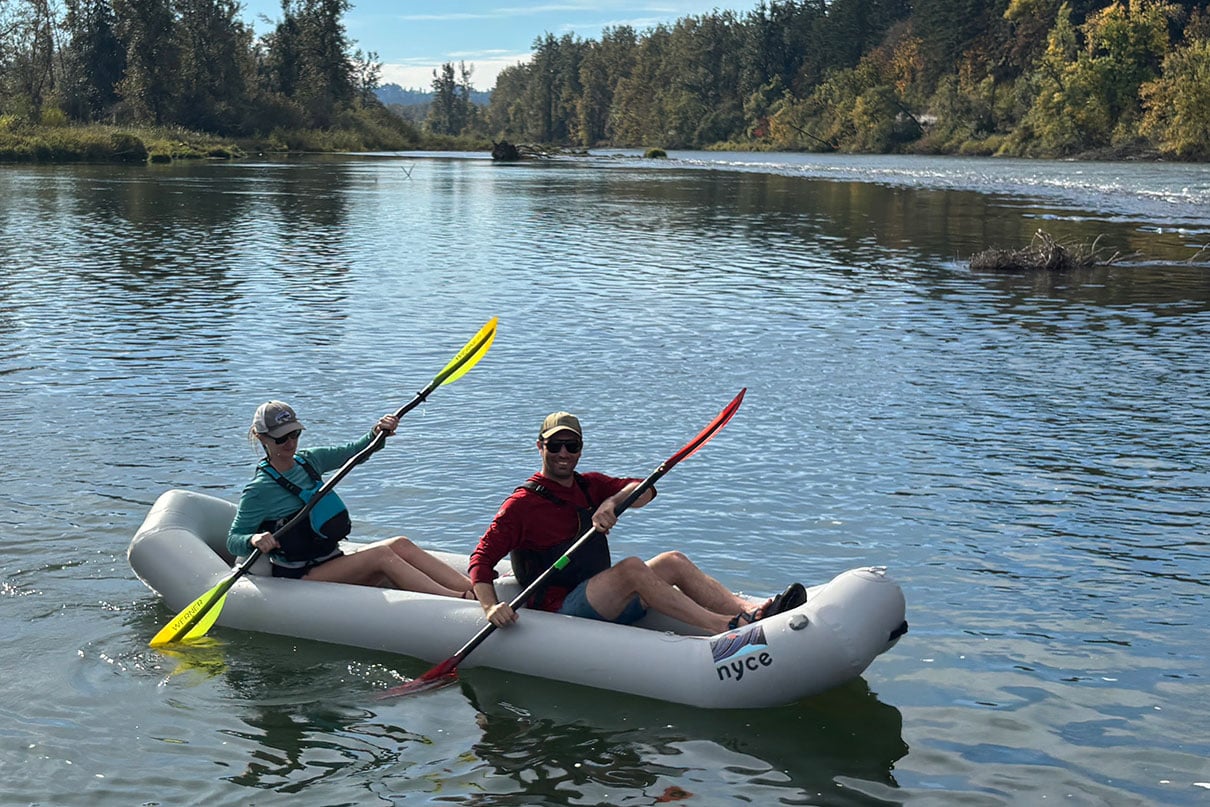
Nyce Haul Specs
Length: 11’2″
Width: 40″
Weight: 44lbs
Capacity: 500 lbs
MSRP: $1,365
nycekayaks.com
Buy from:
Why I Love It
Something you’ll notice about many inflatable kayaks is that they can be set up as either solo or tandem boats. This is incredibly helpful if you are only going to have one kayak that you may be sharing with a friend, family member, or significant other, and other times going it alone. The Nyce Haul is my current favorite tandem inflatable kayak, no matter whether the plan is to set up for a day on the river as a duo or pack down with gear solo on a multi-day trip. This kayak is best suited for whitewater, though it also works well for slow-moving rivers, and is fantastic for after-work floats, which I do often on the Willamette River.
The reason why the Haul is such a great setup is because of how easily the backrests are to move around. Not only that, but because of how thoughtfully simple they are. While many inflatables have moved to more elaborate back and bottom, folding-style seats, the Nyce just uses round cross tubes filled with air that are attached to interior D-rings with just a cam strap.
The Haul also has a drop-stitched high-pressure floor that keeps your bottom out of the water and makes the boat more rigid, and punches through waves well. I have taken it on lakes, hoping the stiffer floor would help on flatwater some, but it’s nothing like a high-pressure paddleboard, and wouldn’t be my first choice for the task. The drop-stitch floor also easily removes, giving it some give to avoid popping on rocks, or to use as a sleeping pad for a lunch spot nap.
Reasons to buy
- Great for whitewater or river floats
- Easy to outfit and adjust two-person inflatable kayak, but also converts to a solo
- High-pressure floor increases rigidity to punch through waves
Consider another if
- You plan to paddle mostly flatwater and only occasional small rapids
- You want more elaborate seats and footrests
Bottom Line
Whether you are going it alone or teaming up, the Haul is a thoughtful tandem inflatable kayak for any river trip.
Best for lakes and bays
Gumotex Seashine
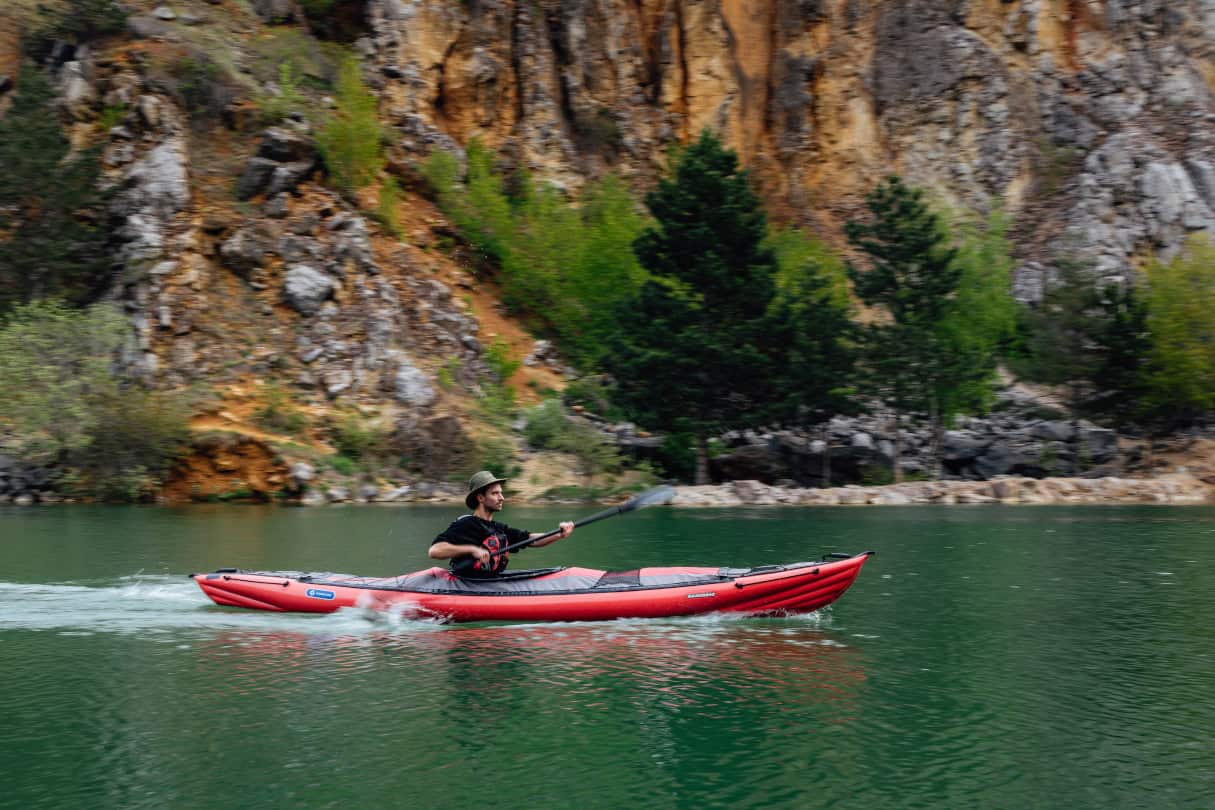
Gumotex Seashine Specs
Length: 15′ 5′
Width: 32”
Weight: 42 lbs
Capacity: 551 lbs
MSRP: $2,750
gumotexboats.com
Buy from:
Why I love it
Inflatable kayaks tend to be less than ideal on flatwater. There are a few reasons for this, including their high buoyancy, lack of detailed hull shape and less rigidity. It all adds up to a boat that doesn’t travel in a straight line or cover ground well without the help of the current. This is not the case for the Gumotex Seashine. The Seashine incorporates what’s called a V-hull toward the front half of the kayak. A V-hull gives the kayak hold in the water, which helps it track in straight lines, cut through the water, and even provide better stability in rolling seas. V-hulls are common on hard-plastic and composite touring kayaks, and the Seashine blends this with the benefits of an inflatable.
The Seashine also has a high-pressure floor and a slot for a fin under the stern which are also extremely helpful to make the boat more rigid and hold a line when touring to cover ground in flat or choppy waters. The outfitting also allows for the kayak to be set up to paddle solo or with others.
Reasons to buy
- V-hull and drop-stitched floor create one of the best flatwater inflatable kayaks
- Accessories available from Gumotex including deck covers to make it a sit-inside and even an attachable stern rudder system
- Lighter and easier to transport than similar-sized or larger plastic and composite kayaks
- Can be set up as a one-, two-, or three-person kayak
Consider another if
- You want the performance or features of a hardshell kayak for ambitious outings or expeditions
- You plan to paddle whitewater extensively
- You are looking for a budget-friendly flatwater inflatable
Bottom line
Inflatables are only fun on flatwater if you pick a kayak tailored for it, and the Gumotex Seashine is an excellent option.
Favorite Packraft
Kokopelli Recon Self-Bailing
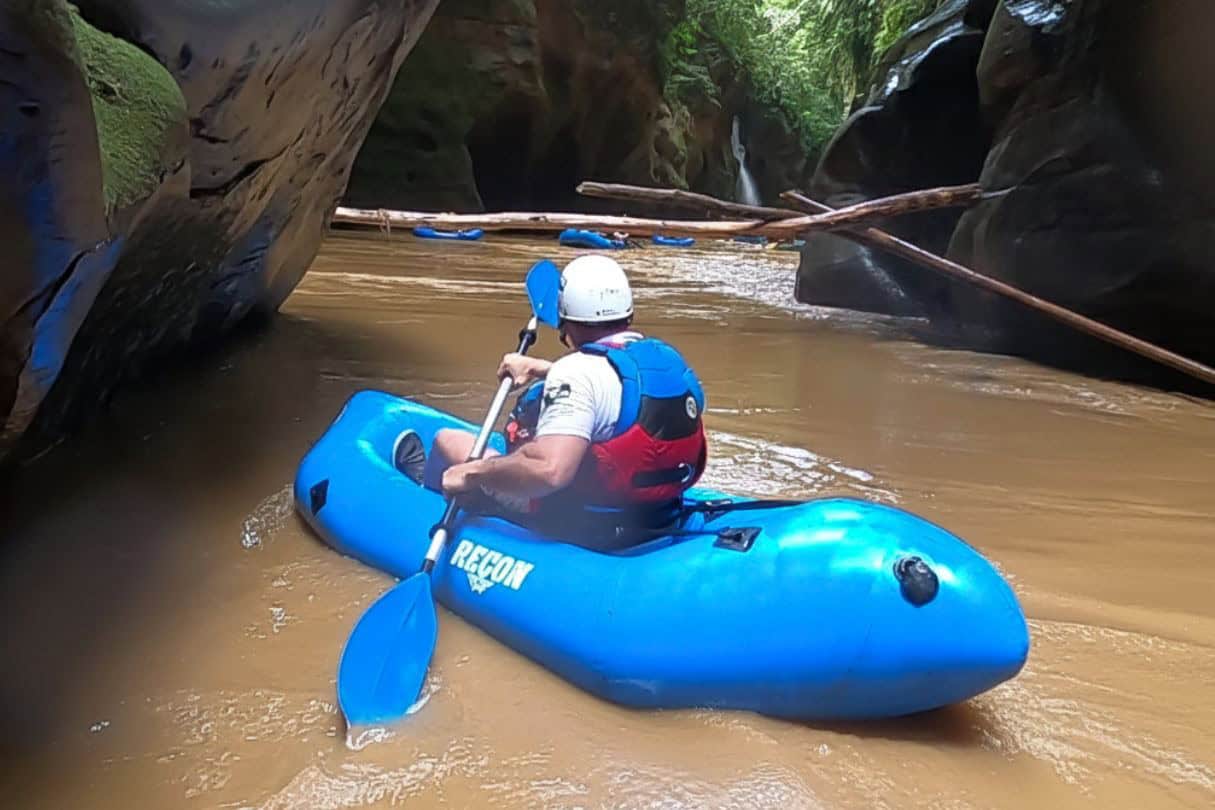
Kokopelli Recon Specs
Length: 7’6”
Width: 37”
Weight: 15.9 lbs
Capacity: 300 lbs
MSRP: $1,049
kokopelli.com
Buy from:
Why I love it
Packrafts have become a great gateway to the sport of kayaking, especially for running whitewater rivers, where they offer capable alternatives to the traditional and steep learning path of closed-deck plastic kayaks. They are essentially a special type of inflatable kayaks, and with a packraft you can enjoy the best parts of the sport sooner. The category has boats for ever type of paddling, ranging from flatwater to whitewater. For me, and the love of running rivers, the Kokopelli Recon is one of my favorites. The packraft has a wide, bulbous platform that creates stability, a flat bottom hull to spin and dance your way through maneuvers in rapids, and ample rocker to carry you over river features. There are packrafts that have since come out designed for harder whitewater, but the Recon is capable of class III-IV whitewater and costs significantly less than more hardcore models. The Recon self-bailer is a sit-on-top style with an open deck that lets splashing waves drain through the floor, but it is also available in a spraydeck version for those who prefer. It also has a T-zip at the stern for interior storage, which is like having a built-in dry bag.
Another reason packrafts are popular is their lightweight and smaller size compared to the thicker construction of traditional inflatable kayaks. This is great for van lifers, or those heading to the most obscure hike- or bike-in destinations. For the river runner, the Recon is a sturdy-built packraft that offers a great balance of packability, durability, performance and cost.
Reasons to buy
- Balance of whitewater-capable and affordable packraft
- Great for learning the ropes of kayaking or having a friend jump in to run
- Lightweight even by inflatable standards
Consider another if
- You want to tackle the hardest whitewater in a packraft, in which case consider the Kokopelli Rodeo or Alpacka Valkryie
- You are focused on all-day comfort over packability and sportiness–then look toward traditional whitewater IKs
- You plan on paddling flat or slow moving water, then a less whitewater focused packraft will be your best bet
Bottom line
For the traveling river runner, the Kokopelli Recon offers a great balance of packability, durability, performance and cost.
Best Inflatable Fishing Kayak
BOTE LONO Aero
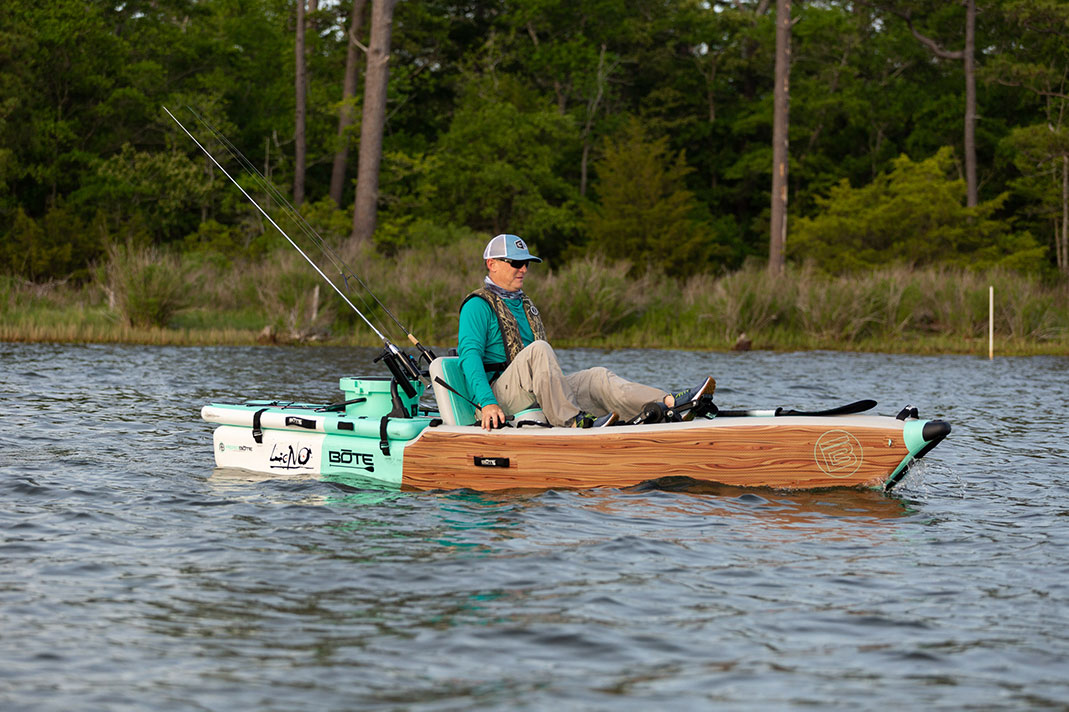
BOTE LONO Aero Specs
Length: 12’6″
Width: 35.5”
Weight: 51 lbs
Capacity: 400 lbs
MSRP: $1,749
boteboard.com
Buy from:
Why I love it
When I think about what makes a fishing kayak stand out from any other inflatable kayak, it comes down to two things. One is customization. The other is the ability to stand and sight cast. Inflatables aren’t generally known for either, which is why BOTE’s LONO Aero is fun and unique.
I remember when I first started unpacking the LONO setup. First was the hull, then a great seat, and after that, I was surprised to find the inflatable platform for the stern. But that was only the beginning. The next thing I knew I was unpacking the optional to use pedal drive, the Kula cooler, the Rocket Rac rod holder, and the Sandspear push pole and spike. It sounds like an elaborate system for an inflatable, which it is. But the beauty is that I could decide how much or how little I wanted to build on for a day of angling. The best part, I didn’t need a trailer to haul it.
The second point is the ability to sight cast. While most inflatable kayaks have lower psi floors, the LONO Aero has a drop-stitched high-pressure floor that allows you to stand up with confidence and sling your lure, whether by spinning reel or fly rod.
Reasons to buy
- Customizable to create as elaborate or simple of a setup you need to fish for the day
- Drop-stitched floor provides higher psi and a standing platform for sight casting
- BOTE accessories are unique and useful
Consider another if
- You want the choice to outfit your kayak with third-party accessories
- You are looking for a budget-friendly option
Bottom line
The BOTE LONO Aero is a fun, unique and useful inflatable fishing kayak, and the brand offers as elaborate a fishing rig as you desire.
What to consider when buying an inflatable kayak
Inflatable kayaks are produced a wide spectrum of quality. What you are looking for in an inflatable kayak will also depend on how you plan to use it.
The construction of varying degrees of inflatable kayaks is likely one of the largest differences between boats. The best inflatable kayaks are made of stronger, thicker, pliable plastics. A poorly constructed inflatable kayak is very often made with thin plastics that feel like they belong to an inflatable pool toy. Packrafts are an exception, having managed to use thinner material technology that is very light, but durable and easy to repair.
Air valves are also a factor. In order to reach proper inflation, a well-designed inflatable kayak features valves that can be placed into a position to allow air in but not out during inflation. This allows you to be able to put the maximum recommended air pressure into each tube. Proper inflation and tube construction equate to a tandem kayak that is more rigid for effective paddling. A spongy kayak feels sluggish to paddle and folds when hit by waves, making the experience less enjoyable.
Also, consider how many air chambers the inflatable kayak has. Air chambers are what keep you afloat, and while standup paddleboards have yet to regularly adopt multiple chambers, most well built kayaks will have a few, which provides a safety element. Should a chamber pop you will still have air in one or two others.
The overall shape of a kayak influences whether it is made more for rivers or flatwater. A tapered kayak with a pointed bow and stern, less lift at the bow and stern, and even a v-hull are signs the boat is intended for flatwater. A more bulbous shape, with a lifted and round nose and tail are usually associated with an inflatable kayak made for running rivers. The outer tube diameter is another factor to consider here. The larger the tube diameter, the more of a pontoon each will provide to keep you riding high and stable. A larger tube diameter is especially important on whitewater, and much less so on flatwater. You do, however, also want to consider whether the size of the tube diameter inhibits your ability to self-rescue back into the boat should you capsize. If you have the chance to test paddle a kayak, consider attempting a self-rescue.
Best Inflatable Kayak Brands
- AIRE
- NRS
- Sea Eagle
- Advanced Elements
- Nyce
- BOTE
- Jimmy Styks
- Alpacka
- Kokopelli
- Rocky Mountain Rafts
- Z Pro
- Hobie
- Aquaglide
- SOTAR
- Gumotex
How we tested
To create this list of the best inflatable kayaks, we took popular boats available today out on our favorite local waterways, as well as gathered the feedback of editors and contributors and their reviews conducted over years of editorial coverage.
Why Trust Us
Digital Editor Joe Potoczak has been paddling inflatable kayaks since he first started working on rivers nearly 25 years ago. He has spent many summer days figuring out which are the most comfortable, most fun, and best to get others into the sport.



